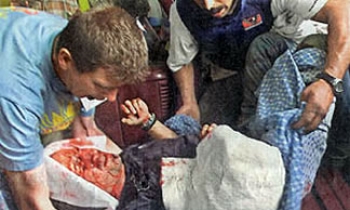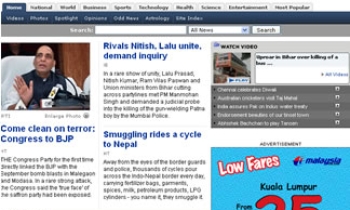For the Sun, Feb. 20 was a banner news day. The tabloid London newspaper led its front page with an exclusive story on lingerie model Caprice Bourret checking into rehab. The story's three paragraphs were dwarfed by a poster-size color photo of the California-born woman wearing nothing but a bra and panties -- an image tailor-made for a newspaper that thrives on images of topless Page 3 Girls and stories about celebrity affairs, sex and scandal.
Crowding the Sun's front page that day was a photo of Britney Spears wearing a "trashy blonde wig" to cover her newly shaved head. Relegated to the second page was a report on U.S. plans for strikes on Iran if evidence showed Tehran was involved in the deaths of American personnel in Iraq.
Almost 3 million people bought the paper with Bourret on the cover, but readers who visited the tabloid's Web site could find much racier fare, including videos of Page 3 models exposing their breasts and posing on the ground like full-fledged strippers; photos of British and Hollywood actresses wearing clothing that reveals more than cleavage; and a film trailer for the R-rated movie "Notes On a Scandal" that shows truncated scenes implying sex between a middle-age teacher (played by Cate Blanchett) and one of her 15-year-old students.
"You must create video content that will appeal to your audience," said Marc Webber, assistant editor of the Sun's news site, in a phone interview from London. "We know our readers love Page 3. The videos we show we deem to be (appropriate even for readers) 15 and under."
On average, the Sun's Web site attracts 9 million unique visitors a month, making it one of the most popular news sites in the United Kingdom. By comparison, only a few U.S. newspaper Web sites attract as many readers.
Webber is surprised that more American news organizations aren't following the Sun's lead on Hollywood film trailers, which he says give readers a new connection to upcoming movies.
More scantily clad women in papers on this side of the Atlantic? As previously risque images become a more-acceptable part of American culture, some U.S. news outlets already are showcasing models in bikinis. The Chicago Sun-Times has on its Web site several videos featuring Sports Illustrated swimsuit sessions, one of which has singer Beyonce Knowles posing provocatively on a beach, hooking her fingers inside her bikini bottom.
"It's soft porn," Tom Hymes, publisher of the adult entertainment trade magazine XBiz, said of the videos. "That's what they can get away with for now."
The boundaries between news and entertainment have always been blurry. But as American newspapers experience a precipitous decline in readership, they might be tempted to decide that a greater emphasis on entertainment and tabloid coverage -- of celebrities, of gossip, of provocative images and subjects -- can help save their bottom lines. Newspapers know there's an insatiable appetite out there for splashy coverage. For example, just one hour after SFGate.com, The Chronicle's Web site, ran an Associated Press story on Spears leaving rehab for the second time in a week, that story was the fourth most-read piece on the site, beating out news profiles of Barack Obama, former White House aide Scooter Libby, and even Barry Bonds.
Newspaper editors are generally cautious about catering to the baser instincts of some readers, fearing that may offend other readers or make the paper seem lightweight. But the tension between a paper's ideals and the demands of the marketplace have always existed, creating a shifting balance of hard and soft news. It's not just the tabloids. The death of Anna Nicole Smith got lots of ink in the New York Times and every other major paper in the country.
"Already, you're seeing a fair amount of celebrity coverage," newspaper analyst John Morton said. "It's not salacious, but newspapers have in recent years devoted more attention to stuff like that than they used to.
"It's a continuation of broadening the definition of 'news,' " Morton said . "Back in the '70s, there was a pretty clear definition -- it was hard news. But starting with the New York Times and spreading to other newspapers, it's gone on to include coverage of food and cooking and gardening and lifestyles and all kinds of other things you never used to see in newspapers."
The history of newspapers offers lessons in catering to the public's changing desires. In the mid-19th century, for example, papers never covered sports on a regular basis. It wasn't until the 1890s, when they realized it would boost circulation, that papers regularly wrote about baseball and other athletic endeavors, according to Charles Ponce de Leon, an associate professor of history at New York's Purchase College and the author of "Self-Exposure: Human-Interest Journalism and the Emergence of Celebrity in America, 1890-1940."
By the 1920s, when Babe Ruth was the most famous man in America, newspaper balance sheets were dependent on the public's interest in sports. As Ponce de Leon points out in the book, "Because of the importance of sports to the economic fortunes of many newspapers, in the early 1900s editors began funneling many of their best writers to the sports department, where they were handsomely paid and given extensive artistic license."
Beginning in the 1890s, newspapers also boosted circulation with gossip columns that tracked the famous -- politicians, businessmen, actors and others -- as well as soft-news features on well-known people, according to Ponce de Leon. Even the New York Times, an upmarket paper that sought readers from society's higher strata, ran stories that trafficked in gossip and the private affairs of public figures. One of the leading papers of this period, the New York Herald, defined news as anything of interest to readers. Among those who complained about the press' telescopic reach was aviator Charles Lindbergh, whose personal life was picked apart by the media after his 1927 solo crossing of the Atlantic Ocean. The public couldn't get enough information on Lindbergh, even if some of it was false. Reporters took to stalking the pilot, and to bribing his staff for information, Ponce de Leon says.
As with sports, the quest for stories about Lindbergh can be linked to newspapers' quest for more profit -- in terms of increased sales and readership, and in terms of advertisers who wanted to reach that readership.
"Lindbergh came into the public eye when a lot of these trends were amplified," Ponce de Leon said in a phone interview. "By 1927, the so-called quality press was more deeply engaged in human-interest journalism and the coverage of celebrities than ever before. Part of (the goal for papers) was to fill pages. Remember, the business of newspapers is to sell advertising. If there are vendors who are going to place ads, you need to fill up the pages on which the ads appear with copy. So, in this period in particular, it meant filling up pages with copy that people would read."
Many of those stories were about the personal lives of tobacco heiress Doris Duke, whom Ponce de Leon likens to Paris Hilton, and other New York celebrities. "They were continually battling addictions," he said of Duke and other young female news subjects of the 1920s and 1930s. "In coded ways, you could see reference to their battles with eating disorders and all kinds of things. And there was regular coverage of (Duke's) romantic problems."
The subtext of that coverage, he says, was reader interest in the subject's sex life -- just as it is in 2007 with coverage of Spears, Hilton, Smith and other women who are deemed young, successful and attractive.
"Sex is the ultimate mystery," Ponce de Leon said. "If you think about it, the curiosity about celebrity is a curiosity about who they really are, and that means (reading about and seeing) them in spheres in which they are largely out of public view. The ultimate place, of course, would be the bedroom, and the ultimate activity would be sexual activity -- especially since the 1920s, when most people have regarded their sexuality as an element of their selfhood, as integral to who they are as a person. Sex certainly sells a lot of papers and magazines."
For the Sun of London, which is owned by Rupert Murdoch and edited by a woman (Rebekah Wade) who supports the Page 3 format, images of sexually provocative models certainly sell papers. But public depictions of nudes are more acceptable in Britain than in the United States. The Sun's approach might never work in America, but Ponce de Leon envisions a day -- perhaps in the next few years -- when U.S. newspapers regularly report and comment on pornography, which generates $12 billion a year in revenue in this country. The most explicit stories might only appear on a paper's Web site, not in print, he said, but their presence would be publicized to the paper's wider readership. In September, SFGate.com hired a sex columnist, Violet Blue, whose work is available only online.
"That's the direction the culture is moving in," Ponce de Leon said. "The diffusion and decentralization of sources of information will make (papers' coverage of pornography) inevitable, just as it will be inevitable that varieties of pornography for every taste will be piped into homes through video-on-demand. There'll be packages (of pornography) just like there are in sports. That's not to say that people won't be upset. They will. But that's the direction the culture is clearly moving in."
Another sign of that direction, says XBiz's Hymes: U.S. phone companies are preparing for the day when mobile users can order soft-core images and film clips on their cell phones. The companies would earn millions from the practice, and would follow in the footsteps of phone companies in Britain, which generate big profits from soft-core images. Hymes says he learned about U.S. phone companies' interest in the mobile market for soft-core images a few years ago when he was the editor of Adult Video News magazine, and "We were approached by a middle man for the top (phone) carriers. They were open to it. Previous to that, they wouldn't go there at all."
For anyone who looks at YouTube, this development won't be a shock. Although it has policies that prohibit scenes of graphic sexuality, YouTube has videos of "Barbie Sex" (people simulating sex between Ken and Barbie dolls), commercials and videos showing sex among gay and straight couples, and excerpts of R-rated movies, such as the scene from Monty Python's "The Meaning of Life" in which actor John Cleese teaches a sex class, talks repeatedly about women's genitalia, then gets on top of his wife, who has taken off her underwear.
The New York Times' Web site promotes reviews by its chief critic, A.O. Scott, that feature clips from R-rated films, including a scene from Mel Gibson's "Apocalypto" in which a man raises a knife over another man being held down for sacrifice.
Ten years ago, the idea of newspapers offering TV and movie clips would have been unimaginable. In just a decade, though, the barriers between news and entertainment have fallen fast. The pace may pick up as newspapers fight for their lives. Can newspapers resist the temptation to link their salvation to Britney, Paris and trashy movie trailers?
E-mail Jonathan Curiel at jcuriel@sfchronicle.com.









